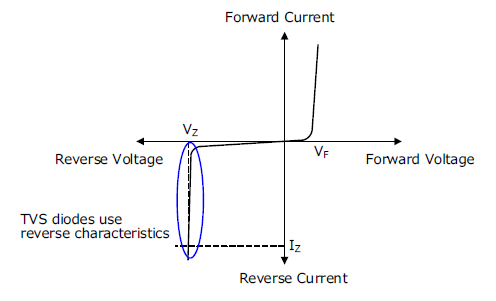Types of Diodes
The following table shows the types of our diodes. This section describes the applications and features of each type of diode.
| Junction Type | Diode Type | Product List |
|---|---|---|
| PN Junctions | General-purpose Rectifier Diodes | URL |
| Fast Recovery Diodes | URL | |
| High Voltage Rectifier Diodes | URL | |
| Snubber Diodes | URL | |
| TVS Diodes | URL | |
| Alternator Diodes | URL | |
| Schottky Junctions | Schottky Diode | URL |
General-purpose Rectifier Diodes
General-purpose rectifier diodes are used for commercial power supply rectification (50 Hz / 60 Hz) and reverse connection protection circuits. These diodes have high breakdown characteristics.
Fast Recovery Diodes
Fast Recovery Diode (FRD) is used for rectification of high frequency (tens to hundreds of kHz) such as switching power supplies. Compared to general-purpose rectifier diodes, the reverse recovery time, trr, is shorter. While trr of a general-purpose rectifier diode is several μs to several tens of μs, trr of FRD is several tens to several hundreds of ns.

The reverse recovery time, trr, of FRD is short because holes are captured by carrier traps near the junction. As shown in the following figure, when holes that have penetrated to the N-layer move to the P-layer, the carrier traps in the N-layer capture the holes and quickly eliminate the holes to shorten trr.
However, there is a trade-off relationship between trr and forward voltage drop, VF, and thus, providing a carrier trap structure to shorten trr increases VF. Conversely, lowering the VF increases trr.

Since the FRD recovery current causes power loss, the peak value of the recovery current should be small. When the recovery current recovers abruptly, a ringing occurs, resulting in noise, therefore, the FRD with a smaller recovery current and a softer recovery has better characteristics.

High Voltage Rectifier Diodes
High-voltage rectifier diodes for consumer use are used in microwave oven inverter circuits and high-voltage circuits. Automotive high voltage rectifier diodes are used for ignition coils of fuel injection systems.
Snubber Diodes
Snubber diodes are auxiliary switch diodes especially designed for snubber circuits, which are used in the primary-side of flyback switching power supplies. They reduce the ringing voltage generated at power MOSFET turn-off, contributing to improvement of the efficiency of switching power supplies and noise reduction.

Alternator Diodes
Alternator diodes can withstand the harsh environments of the automotive engine room. They are available in surface mount and pressfit type packages.

TVS Diodes
Transient Voltage Suppressor (TVS) diodes are used to protect circuits and devices from overcurrent, overvoltage, and surges. The reverse voltage of the TVS diodes during breakdown is almost constant regardless of the current flowing. TVS diodes use the reverse characteristic to protect circuits and devices.

Schottky Diode
Schottky diodes use the barriers created by Schottky junctions. Compared to PN junction diodes, Schottky diodes have a lower forward voltage drop, VF, and a shorter reverse recovery time, trr, making them suitable for high-speed switching. trr has no temperature dependence and thus trr is the same at all temperatures.
However, compared to PN junction diodes, Schottky diodes have a larger reverse leakage current, IR, and higher power loss (IR × VR). The higher the temperature, the higher the power loss. Hence, it is required to design the heat dissipation so that thermal runaway does not occur.

The breakdown voltage of Schottky diodes is lower than that of PN junction diodes, and it is difficult to achieve high breakdown voltage (generally up to 150 V). As shown in the following figure, the breakdown voltage is increased by thickening the N-layer and lowering the carrier concentration. However, the loss increases because the resistance increases and VF also increases and thus the performance is out of the practical use range. We are developing a high breakdown voltage and practical SiC Schottky diode using next generation power semiconductor SiC.

The height of the Schottky barrier depends on the type of metal connected to the semiconductor. The electrical characteristics are different depending on the type of metal. As shown in the following figure, there is a trade-off relationship between the forward voltage drop, VF, and the reverse leakage current, IR, depending on the type of metal. Select the metal according to the target characteristics.

